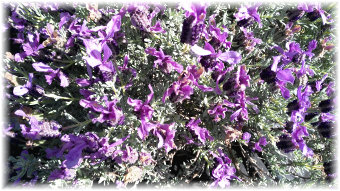


Lavender (lavandula) (Labiatae - Lamaceae, Mint family) Characteristics and uses:
Etymology: The english word is generally thought to be derived from old french lavandre, ultimately from the latin "lavare" (to wash), referring to the use of infusions of the plants. Other uses: It is used also as condiment and used in salads and dressing. Flowers can be candied, used also as cake decorations. Lavender flavour pairs especially well with chocolate, and it is also used to make "lavender sugar". With other herbs, such as chamomile, it is used in aromatherapy. Lavender essential oil , is approved for use as an anxiolytic in Germany. The U.S. National Institutes of Health states that lavender is considered likely safe in food amounts and possibly safe in medicinal amounts (with the exception of pregnant, breast-feeding women and young boys). Lavender essential oil is used for restlessness, insomnia, depression and nervousness. History and folklore: The ancient Greeks called the lavender herb "nardus", after the Syrian city of Naarda. This herb was one of the holy herbs used in the biblical temple to prepare the holy essence (from the song of Solomon "nard and saffron, calamus and cinnamon, with every kind of incense tree, with myrrh and aloes, and all the finest spices"). During roman times, flowers were sold for 100 denarii per pound, about the same as a month's wages for a farm laborer (a lot of money!). The essential oil was used in hospitals during World War I. In the language of flowers it means serenity, grace, calmness, love and loyalty at first sight, shows enchanting, respect even mystery, but It could symbolize also distrust. **** Erbe Matte cannot take any responsibility for any adverse effects from the use of plants. Always seek advice from a professional before using a plant medicinally**** **** We carefully dry lavender stems when they are crisp, at the first bloom; after they are dried, we remove the leaves and flowers by sliding our fingers down each stem**** **** When cooking with lavender, be sure using culinary/edible lavender and not lavender treated with chemicals. **** |
 It is a genus of 39 known species of flowering plants, native to the old world, found from Cape Verde and the Canary Islands, Europe, northern and eastern Africa, Mediterranean, southwest and southeast India. This evergreen shrub is at the same time a ornamental plant and also a culinary herb, as well commonly used for the extraction of essential oils. Lavandula angustifolia and Lavandula stoechas are the best known in this family. The flowers, blooming in late spring and early summer, are pink to purple (rarely white). Commercially, the plant is grown mainly for the production of
It is a genus of 39 known species of flowering plants, native to the old world, found from Cape Verde and the Canary Islands, Europe, northern and eastern Africa, Mediterranean, southwest and southeast India. This evergreen shrub is at the same time a ornamental plant and also a culinary herb, as well commonly used for the extraction of essential oils. Lavandula angustifolia and Lavandula stoechas are the best known in this family. The flowers, blooming in late spring and early summer, are pink to purple (rarely white). Commercially, the plant is grown mainly for the production of 